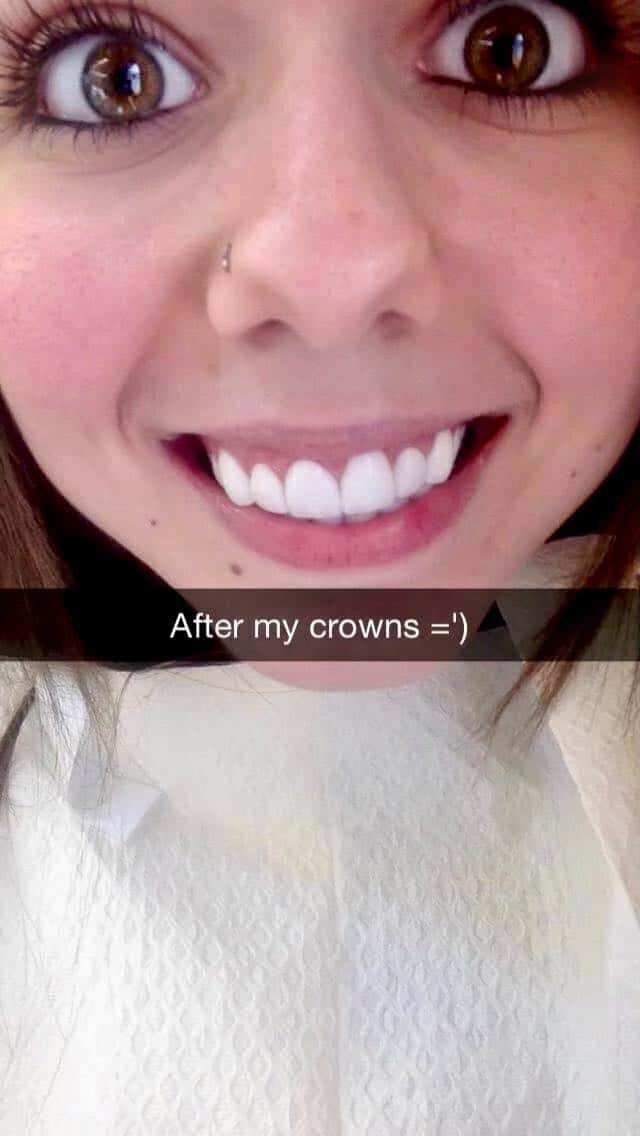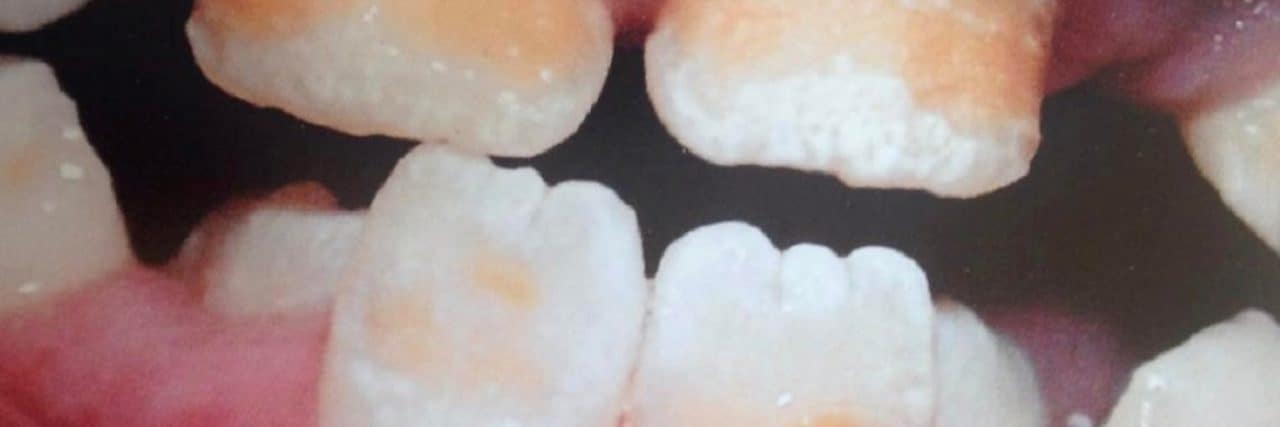The world tried to take away my smile.
As a child, I learned very quickly that I was not to smile or talk. My teeth were streaked with yellow and brown. They were pitted, grooved, and unusually small, with gaps bigger than my actual teeth. Every smile, sigh, whisper, and word I spoke revealed the formation of my teeth. I saw that I was ugly, unwelcome, rotten, and disgusting. My existence was raw, exposed, and vulnerable for all the world to see.
I was born this way. I have a rare genetic disorder known as amelogenesis imperfecta (AI). It affects only 1 in 14,000 to 16,000 people in the United States, which is about 0.007% of the population. AI is a disorder of tooth development that involves the formation of enamel and results in teeth that are discolored (yellow, brown, grey), pitted, grooved, brittle, and unusually small. My teeth are naturally uncovered, with the nerves and dentin exposed.
It may be clinically clustered with other rare syndromes, including nephrocalcinosis (a kidney disorder), skeletal disabilities, cone-rod dystrophy (vision loss), epilepsy, dementia, intellectual or developmental disabilities, and fragile nails or bones.
I know what it is like to bleed by the mouth from just trying to eat, to cringe in pain from the air hitting my nerves, and to go hours and days numb, unable to talk. As a child, I was selective with food because temperatures or textures were often painful. Food felt like I was either digging my teeth into ice cream or trying to rub sandpaper on my teeth.
Without the natural protective covering, the air temperature from breathing sometimes brought sharp pain. Food tasted like pain and humiliation.
I was desperate to brush off the ugly. While kids my age were playing games outside or watching a movie, I would frantically brush my teeth. Hours would pass as I brushed every tooth, one by one, each day. I think my record was four hours straight. My teeth throbbed, but I did not stop. Why didn’t my teeth look like other kids my age? I wanted to brush away the ugly, but most of all, I wanted to try to save my teeth.
I did not smile, because I thought no one should see what I really look like. I thought no one should see my face until I single-handedly fixed it. A child does not know any better.
I have not encountered or learned of another person with AI, and there remains a lack of research on the disorder across all disciplines. Sometimes when I see other peoples’ teeth, I feel a sense of disconnection. Given that I have never experienced teeth with enamel and protective covering, I do not understand what it is like. I suspect that most people have never stopped to ponder the way straight, white teeth are a social prerogative or used to infer a character judgment, such as friendliness and cleanliness.
Luckily, I was homeschooled, so I happened to escape most if not all pejorative remarks and messages. My siblings and friends did not care, but I still grasped that I was different, and not the “good kind” of different.
Dental appearance tends to be attributed to good hygiene, moral behavior, or lack thereof despite the combination of factors that more heavily influence the appearance of teeth, including social class (e.g., inability to afford dental care), disability, medical conditions, or medication side-effects.
“Ugly” teeth are often the brunt of a joke or cruel internet meme. “Meth head” and “drug addict” are thrown around at people who have “ugly teeth.” Yet, the only difference between me and these people is access to dental care.
Indeed, disability is often used as a moralistic crutch, plot device, and punishment in popular culture. “Ugly teeth” are the “life lesson” of the day. “That is what happens when you don’t brush your teeth and eat sugar all day!” I assimilated that it was my fault. It was my fault. It was my fault.
The medical ableism and the barriers are other pertinent parts of the rare disease experience. Dental care is considered separate from medical insurance, a problem that results in even further barriers to care. Even more, dentists may not have familiarity with such a rare genetic disorder. I remember when my mother confronted a dentist who told me to “brush better.” Excuses usually consisted of “I must not have read the condition on the chart.” All I heard was four hours was not enough.
The insurance company initially refused to cover any treatments for my teeth. They had never heard of such a condition. The majority of people with AI lose teeth or need multiple root canals as children, which I assume my access to dental care and four-hour-long teeth brushing helped me avoid entirely. Without the teeth coverings, however, losing my teeth as I grew up would be inevitable.
My dentist diligently contacted the insurance company with a thorough letter that described the realities of this condition and the importance of covering my teeth while I am young, as soon as possible. First, insurance only agreed to cover temporary bonding, which was enough to protect them initially.
When I was in my mid-teens, insurance finally began to “cover” some permanent, porcelain crowns — except that each individual tooth cost over $800, and insurance coverage handled less than half the cost. My top front 10 teeth are now covered with porcelain crowns. The rest of my teeth remain covered in bonding that can last many years.

For a while, I received a compliment on my porcelain white crowns almost every week. Suddenly, everyone wanted to know what kind of toothpaste I use. Suddenly, people accepted my teeth, but I was the same person with the same teeth underneath. I knew the world considered me naturally ugly. I internalized the ableism instead of challenging the standards of being and acknowledging my disabilities.
As a child, I did not understand what I was struggling with was a disability, nor did most people around me. The world presumptuously blames it on “ugly” or improper hygiene. With years of self-awareness and learning, I realized the importance of claiming these characteristics as part of me and my form of being, rather than viewing it through the lens of stigma, failure, or “ugliness.”
Since then, I have learned to view my porcelain crowns the same way the disability community views a mobility aid and other accessibility/adaptive devices. The porcelain white crowns are not separate from me. They do not cover and hide me — they are an important part of me and my story. They are part of my human difference, my experience, and part of my being for better or worse. They are part of accessibility for me to eat, breathe, and live.
I remember my countless hours at the dentist, and the university visits to participate in a case study on AI. I remember the pain. Disability is not always pain-free, even when we take the social barriers out as a factor.
But I also remember the care. My mom tried to make the best out of my memories and always assured me it would be OK. I remember the lunch breaks with my mom during the case study and visits to the park. I remember the kindhearted dentists who gave me my smile back. I remember the scholarship committee that selected me to win a rare disease scholarship two years in a row.
Most of all, I remember eagerly taking the mirror from my dentist the first time my porcelain white crowns were part of me. I looked in that mirror, smiled, then sobbed in the dentist’s chair. A little girl with amelogenesis imperfecta flashed back at me in the mirror for a second. I thought, “This is part of who I am. I am strong. I now have a strong porcelain shell.”

